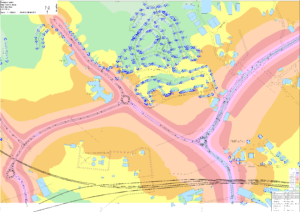NoiseMap can print presentation-ready maps to scale on any Windows-enabled graphics device. However, large paper maps are cumbersome to handle, expensive to transport and a problem to store.
We recommend that you ‘print’ your maps in PDF format. These are easy to handle, transport and store electronically and can be easily viewed on-screen.

Click here to download pdf version of Example Printout
NoiseMap prints maps in vector format. Each object drawn as a series of outlines, filled with colour as required. This means that you can view them in any PDF reader and scale them to any size without loss of quality.
The example noise maps shows an area of 1.5 square kilometres at 1:2500 scale on a ‘virtual’ page which is A2 in size. It fills my screen at 50 %, but the houses are no larger than a pinhead. If I zoom in to 150 %, the houses are a nice size and razor-sharp. I can clearly read the all receiver and contour noise levels as if I was viewing them directly on the noise model – because they are re-drawn at this scale, not enlarged from the smaller scale. Not only that, the file size is very modest – about 4.3 MB. The file size of an A2-size jpeg at this resolution would be astronomical. This is the beauty of vector graphics!
You create the output using the PRINT function of the NoiseMap file menu. But firstly, you need to set up a ‘pdf printer’ to do this. There are a number of ways of installing a PDF printer. If you have Adobe Acrobat Standard, then this will have set up a printer for you, called something like ‘Adobe PDF’. As you can imagine, this is reasonably expensive to buy. A less-expensive system is Win2PDF which works well with NoiseMap, and no doubt there are other cheap or even free systems. You can usually decide to print to one of the standard paper sizes like A4, A3 or A2, or you can choose a your own print size.
